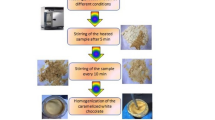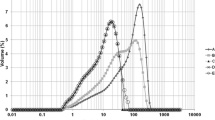Abstract
Compound chocolate and cocolin are widely used chocolate-derived products. However, we have not encountered any study about the influence of the particle size on the various quality parameters of these products. The aim of this study was to determine the effects of particle size on some physical (color properties, particle size distribution, rheology, microstructure and melting properties) and chemical properties (phenolic content, volatile composition and also FT-IR spectra of fats) of compound chocolate and cocolin samples. Refining level did not significantly affect color and melting properties, total phenolic content, thermal properties and FT-IR spectra of the fats extracted from the samples. D 90 values of compound chocolates and cocolins changed between 58.3–18.6 and 60.5–18.2 µm, respectively. Surface area of the samples also increased with refining process. Obtained rheological data were fitted to the Casson model with R 2 values ranged between 0.9863 and 0.999, and the corresponding parameters of the model, namely yield stress (τ 0) and plastic viscosity (η pl), significantly increased with decreasing particle size of the samples. Temperature sweep test was also performed, and temperature dependency of apparent viscosity of the samples changed with respect to refining process applied. Volatile composition of the samples was also determined by HS-SPME–GC/MS, and it concluded that both desired such as pyrazines and undesired such as acetic acid compounds for chocolate changed inversely proportional to particle size. According to the findings of the present study, it can be concluded that refining process and particle size are very substantial factors affecting the quality characteristics of the compound chocolate and cocolin samples.







Similar content being viewed by others
References
Afoakwa EO, Paterson A, Fowler M, Vieira J (2008) Characterization of melting properties in dark chocolates from varying particle size distribution and composition using differential scanning calorimetry. Food Res Int 41(7):751–757
Afoakwa EO, Paterson A, Fowler M, Vieira J (2009) Microstructure and mechanical properties related to particle size distribution and composition in dark chocolate. Int J Food Sci Technol 44(1):111–119
Beckett ST, Francesconi MG, Geary PM, Mackenzie G, Maulny APE (2006) DSC study of sucrose melting. Carbohydr Res 341(15):2591–2599
Glicerina V, Balestra F, Rosa MD, Romani S (2013) Rheological, textural and calorimetric modifications of dark chocolate during process. J Food Eng 119(1):173–179
Servais C, Jones R, Roberts I (2002) The influence of particle size distribution on the processing of food. J Food Eng 51(3):201–208
Do TAL, Hargreaves JM, Wolf B, Hort J, Mitchell JR (2007) Impact of particle size distribution on rheological and textural properties of chocolate models with reduced fat content. J Food Sci 72(9):E541–E552
Ahmed J, Ramaswamy HS (2006) Viscoelastic properties of sweet potato puree infant food. J Food Eng 74(3):376–382
Afoakwa E, Paterson A, Fowler M (2008) Effects of particle size distribution and composition on rheological properties of dark chocolate. Eur Food Res Technol 226(6):1259–1268
Hue C, Gunata Z, Bergounhou A, Assemat S, Boulanger R, Sauvage FX, Davrieux F (2014) Near infrared spectroscopy as a new tool to determine cocoa fermentation levels through ammonia nitrogen quantification. Food Chem 148:240–245
Sokolov AN, Pavlova MA, Klosterhalfen S, Enck P (2013) Chocolate and the brain: neurobiological impact of cocoa flavanols on cognition and behavior. Neurosci Biobehav Rev 37:2445–2453
Afoakwa EO, Paterson A, Fowler M, Vieira J (2008) Particle size distribution and compositional effects on textural properties and appearance of dark chocolates. J Food Eng 87(2):181–190
Periche A, Heredia A, Escriche I, Andrés A, Castelló ML (2015) Potential use of isomaltulose to produce healthier marshmallows. LWT: Food Sci Technol 62:605–612
Di Mattia C, Martuscelli M, Sacchetti G, Beheydt B, Mastrocola D, Pittia P (2014) Effect of different conching processes on procyanidin content and antioxidant properties of chocolate. Food Res Int 63:367–372
Singleton VL, Rossi JA (1965) Colorimetry of total phenolics with phosphomolybdic phosphotungstic acid reagents. Am J Enol Vitic 16:144–158
Mossel B, Bhandari B, D’Arcy B, Caffin N (2000) Use of an arrhenius model to predict rheological behaviour in some australian honeys. LWT: Food Sci Technol 33(8):545–552
Gloria H, Sievert D (2001) Changes in the physical state of sucrose during dark chocolate processing. J Agric Food Chem 49(5):2433–2436
Sokmen A, Gunes G (2006) Influence of some bulk sweeteners on rheological properties of chocolate. LWT: Food Sci Technol 39(10):1053–1058
Amarowicz R, Carle R, Dongowski G, Durazzo A, Galensa R, Kammerer D, Maiani G, Piskula MK (2009) Influence of postharvest processing and storage on the content of phenolic acids and flavonoids in foods. Mol Nutr Food Res 53(S2):S151–S183
Navarra G, Cannas M, D’Amico M, Giacomazza D, Militello V, Vaccaro L, Leone M (2011) Thermal oxidative process in extra-virgin olive oils studied by FTIR, rheology and time-resolved luminescence. Food Chem 126(3):1226–1231
Guillén MD, Cabo N (2000) Some of the most significant changes in the Fourier transform infrared spectra of edible oils under oxidative conditions. J Sci Food Agric 80(14):2028–2036
Fernandes VA, Müller AJ, Sandoval AJ (2013) Thermal, structural and rheological characteristics of dark chocolate with different compositions. J Food Eng 116(1):97–108
Izidoro DR, Scheer AP, Sierakowski M-R, Haminiuk CWI (2008) Influence of green banana pulp on the rheological behaviour and chemical characteristics of emulsions (mayonnaises). LWT: Food Sci Technol 41(6):1018–1028
Vavreck AN (2004) Flow of molten milk chocolate from an efflux viscometer under vibration at various frequencies and displacements. Int J Food Sci Technol 39(4):465–468
Schantz B, Rohm H (2005) Influence of lecithin—PGPR blends on the rheological properties of chocolate. LWT: Food Sci Technol 38(1):41–45
Hassan BH, Hobani A (1998) Flow properties of Roselle (Hibiscus sabdariffa L.) extract. J Food Eng 35(4):459–470
Arslan E, Yener ME, Esin A (2005) Rheological characterization of tahin/pekmez (sesame paste/concentrated grape juice) blends. J Food Eng 69(2):167–172
Abd-Rashid N, Chiew LC, Chong SC, Omar Z (2012) Crystallisation kinetics of palm stearin, palm kernel olein and their blends. LWT: Food Sci Technol 46(2):571–573
Fauzi SHM, Rashid NA, Omar Z (2013) Effects of chemical interesterification on the physicochemical, microstructural and thermal properties of palm stearin, palm kernel oil and soybean oil blends. Food Chem 137:8–17
Owusu M (2010) Influence of raw material and processing on aroma in chocolate. Ph.D. thesis, Faculty of Life Science, University of Copenhagen
Afoakwa EO (2010) Chocolate science and technology. Wiley, UK
Ziegler GR, Mongia G, Hollender R (2001) The role of particle size distribution of suspended solids in defining the sensory properties of milk chocolate. Int J Food Prop 4(2):353–370
Engelen L, Van-Der BA (2008) Oral physiology and texture perception of semisolids. J Texture Stud 39(1):83–113
Counet C, Callemien D, Ouwerx C, Collin S (2002) Use of gas chromatography–olfactometry to Identify key odorant compounds in dark chocolate. Comparison of samples before and after conching. J Agric Food Chem 50(8):2385–2391
Author information
Authors and Affiliations
Corresponding author
Ethics declarations
Conflict of interest
None.
Compliance with Ethics requirements
This article does not contain any studies with human or animal subjects.
Rights and permissions
About this article
Cite this article
Toker, O.S., Sagdic, O., Şener, D. et al. The influence of particle size on some physicochemical, rheological and melting properties and volatile compound profile of compound chocolate and cocolin samples. Eur Food Res Technol 242, 1253–1266 (2016). https://doi.org/10.1007/s00217-015-2629-1
Received:
Accepted:
Published:
Issue Date:
DOI: https://doi.org/10.1007/s00217-015-2629-1




